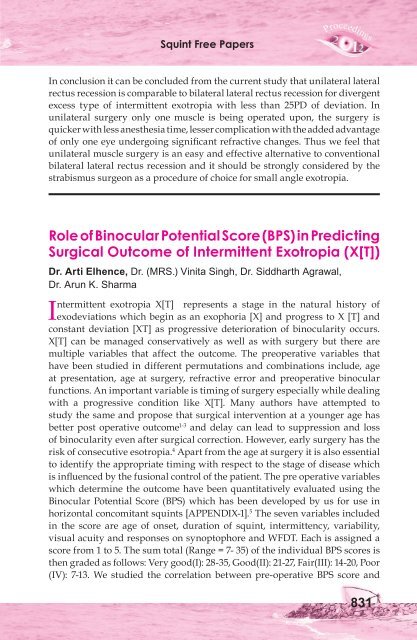Squint Free Papers - aioseducation
Squint Free Papers - aioseducation
Squint Free Papers - aioseducation
Create successful ePaper yourself
Turn your PDF publications into a flip-book with our unique Google optimized e-Paper software.
<strong>Squint</strong> <strong>Free</strong> <strong>Papers</strong><br />
In conclusion it can be concluded from the current study that unilateral lateral<br />
rectus recession is comparable to bilateral lateral rectus recession for divergent<br />
excess type of intermittent exotropia with less than 25PD of deviation. In<br />
unilateral surgery only one muscle is being operated upon, the surgery is<br />
quicker with less anesthesia time, lesser complication with the added advantage<br />
of only one eye undergoing significant refractive changes. Thus we feel that<br />
unilateral muscle surgery is an easy and effective alternative to conventional<br />
bilateral lateral rectus recession and it should be strongly considered by the<br />
strabismus surgeon as a procedure of choice for small angle exotropia.<br />
Role of Binocular Potential Score (BPS) in Predicting<br />
Surgical Outcome of Intermittent Exotropia (X[T])<br />
Dr. Arti Elhence, Dr. (MRS.) Vinita Singh, Dr. Siddharth Agrawal,<br />
Dr. Arun K. Sharma<br />
Intermittent exotropia X[T] represents a stage in the natural history of<br />
exodeviations which begin as an exophoria [X] and progress to X [T] and<br />
constant deviation [XT] as progressive deterioration of binocularity occurs.<br />
X[T] can be managed conservatively as well as with surgery but there are<br />
multiple variables that affect the outcome. The preoperative variables that<br />
have been studied in different permutations and combinations include, age<br />
at presentation, age at surgery, refractive error and preoperative binocular<br />
functions. An important variable is timing of surgery especially while dealing<br />
with a progressive condition like X[T]. Many authors have attempted to<br />
study the same and propose that surgical intervention at a younger age has<br />
better post operative outcome1-3 and delay can lead to suppression and loss<br />
of binocularity even after surgical correction. However, early surgery has the<br />
risk of consecutive esotropia. 4 Apart from the age at surgery it is also essential<br />
to identify the appropriate timing with respect to the stage of disease which<br />
is influenced by the fusional control of the patient. The pre operative variables<br />
which determine the outcome have been quantitatively evaluated using the<br />
Binocular Potential Score (BPS) which has been developed by us for use in<br />
horizontal concomitant squints [APPENDIX-1]. 5 The seven variables included<br />
in the score are age of onset, duration of squint, intermittency, variability,<br />
visual acuity and responses on synoptophore and WFDT. Each is assigned a<br />
score from 1 to 5. The sum total (Range = 7- 35) of the individual BPS scores is<br />
then graded as follows: Very good(I): 28-35, Good(II): 21-27, Fair(III): 14-20, Poor<br />
(IV): 7-13. We studied the correlation between pre-operative BPS score and<br />
831

















